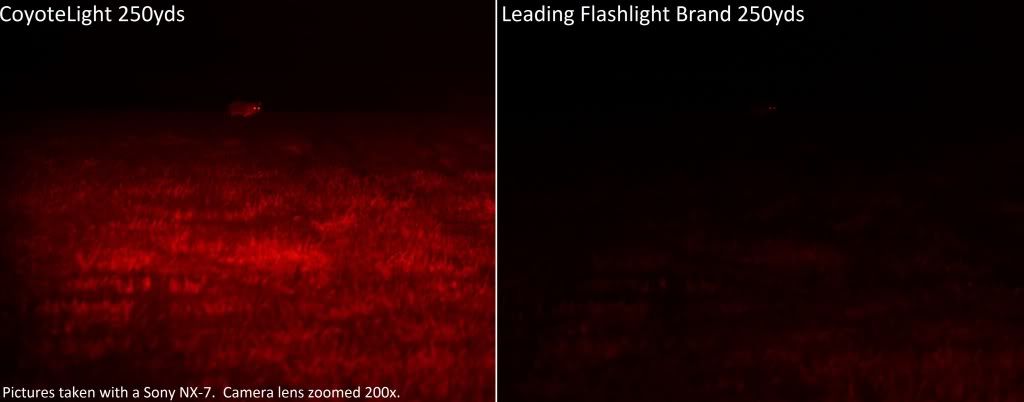Very good question Papa,
There are quite a few major problems with using a white light for hunting at night which are not mentioned in the article. In addition, there is some wrong information that lacks a technical explanation and an argument from opposition.
They obviously have found a method of filming which works for them (hunting from a vehicle), and using six very large white lights (page 42). However, carrying six lights just to see good is not practical or efficient due to the size and weight for most hunters. Here are 5 good reasons to use red:
1. Most predators cannot see red. Canines and fox have dichromatic vision which effectively makes them red-green color blind. When using a red LED light, if a fox or coyote does not come into your call they more likely saw movement or caught your scent.
"a team at the University of California looked at the photopigments (i.e. light-sensitive chemicals) of dogs and foxes. The optometrists found that all the canids in their study possessed two cone pigments, one with a peak sensitivity of about 555nm (light green) and another with a peak between about 430 and 440nm (dark blue / purple). In the Red fox (Vulpes vulpes), this second (short-wavelength) peak was at 438nm. These findings imply that foxes have dichromatic (i.e. two-colour) vision similar to that of a human deuteranope – in other words, it suggests that foxes are red-green colour blind."
http://www.wildlifeonline.me.uk/questions_answers_foxes.html#colourblindFor example, someone could be lighting you up with a night vision scope. However, you would have no clue because you can only see about 700nm of light and the night vision scope is projecting a beam of light over 1000nm. It is the same with canids (carnivorous mammals of the family Canidae: coyotes, fox, wolves, dogs...) which can only see a peak of an estimated 430nm to 555nm.
Another example of how a canid views white lights could be similar to our eyes and UV light. We might be able to sense or feel the UV light, however, we can't see it.
The article mentions that dimming the white light is basically the same as a red light, which is incorrect (Page 41).
2. White light ruins your eyes "night vision". It takes a very long time for your eyes to fully adjust to the dark (20-30 minutes).
In your eye, red light maintains the greatest rod sensitivity possible. "red light does not stimulate the scotopic system."
In your eye, "Rods and cones are not equally sensitive to visible wavelengths of light. Unlike the cones, rods are more sensitive to blue light and are not sensitive to wavelengths greater than about 640nm, the red portion of the visible spectrum."
http://www.aoa.org/x5352.xmlFor example, some other practical applications for red lights are in pilot cockpits for flying at night and photography dark rooms.
Here is a reference to the color spectrum and details about wavelength of light:
http://hyperphysics.phy-astr.gsu.edu/hbase/vision/specol.html3. Seeing contrast at night. In the past I have tried using white lights many times and have always gone back to red. Most properties I hunt have hedge rows or woods.
Byers does note in the article that "One situation where the white light might be inferior to red lights is among trees. In a woodlot, the light tends to bounce from a tree trunk to tree trunk and cause dark shadows, whereas a red diffused light allows the target animal to stand out." (page 44)
4. Red light reflects eyes much better than white. Anyone who has simply tried or compared lighting up a critters eyes with both a white and red light will soon figure out white light is not good for scanning for eyes.
5. Red LED technology has improved. The article mentions that seeing a coyote beyond 100 yards with a red light is difficult (page 41). Until now, most hunter have been using red filters over white spotlights which is very inefficient. However, with CoyoteLight (Red LED, no filter), we have proven the CoyoteLight can identify predators out to 500 yards (with good optics). Here is an example of identifying a coyote at 250yds:

Please let me know if you have any questions.
Brett